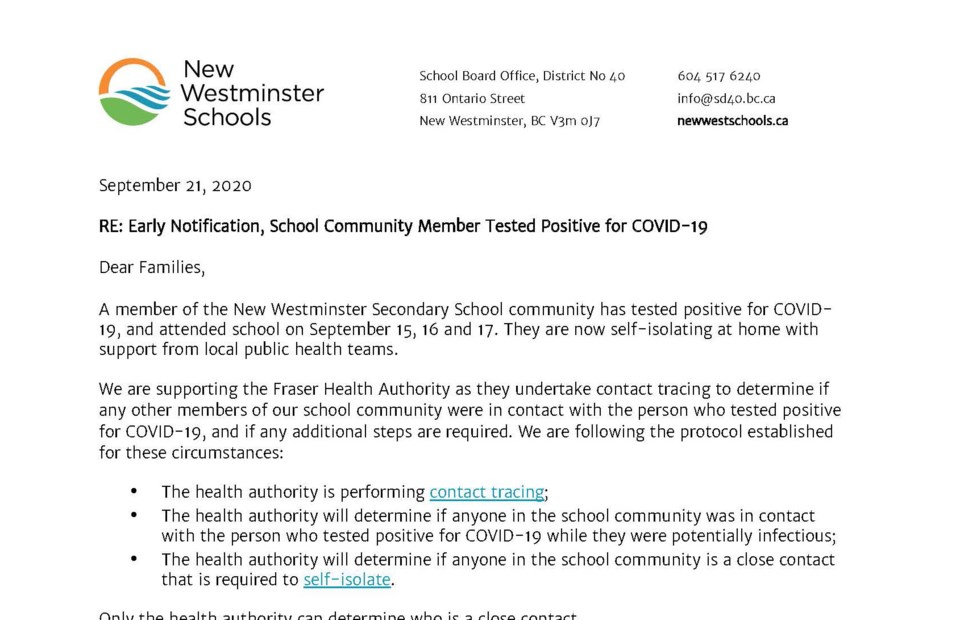An “early notification letter” about COVID-19 in your child’s school isn’t a cause for alarm.
That’s the message from both the New Westminster school district and provincial health officer Dr. Bonnie Henry after September saw a number of COVID-19 exposure notices in B.C. schools – including four so far in New Westminster.
So far, cases have been reported at New Westminster Secondary School, Fraser River Middle School, Queensborough Middle School and Lord Tweedsmuir Elementary School.
At the school board meeting Tuesday night, superintendent Karim Hachlaf reiterated the district’s communication process in the event a COVID-19 case is reported by a member of a school community.
Hachlaf noted Fraser Health takes the lead on all cases. Once a member of a school community (student or staff) tests positive for COVID-19, Fraser Health then determines whether that person was at the school in their infectious period.
If they were, the school then sends out an “early notification letter” to all families at that school letting them know about the case. That letter is sent by the school district after Fraser Health contacts them about the case; Hachlaf noted that those letters have been sent out within hours of contact by Fraser Health.
“That letter is not telling individuals they have been exposed to COVID,” Hachlaf noted.
Details that could identify the person – such as what classroom they’re in – are not provided in the letter for privacy reasons.
Fraser Health is responsible for contact tracing and determining who, if anyone, is considered a “close contact” of the person with COVID-19. At that point, anyone who needs to self-isolate and/or watch for symptoms will be personally contacted by Fraser Health and given specific direction.
In the provincial health officer’s regular Monday press conference, Henry faced multiple questions from B.C. media about various issues surrounding COVID-19 in schools.
She noted that, although there have been “quite a few” exposure events in B.C. since school started, the numbers aren’t extremely high considering how many schools there are in B.C. There have also not been any known in-school transmissions or outbreaks. An “outbreak,” as defined by health authorities, would involve multiple cases of COVID-19 with transmission in the school.
In the event of any COVID-19 case, Henry noted that health authorities will look for where people have been infected, how they’ve been exposed and what type of exposures they may have had at school. She said health officials will always follow up individually with anyone who’s found to be a close contact of an existing case and pointed out that all school exposures will be publicly reported online by health authorities.
(New Westminster exposures are publicly posted on the Fraser Health website.)
“I would encourage parents to recognize that exposure events do not mean that your child has been exposed to COVID-19,” she said. “Unless you’ve had a call directly from public health, you do not need to worry about that. We are being very transparent in putting up where those exposures might have happened so that everybody knows that public health is on it. …
“Just because there’s been an exposure event does not mean you need to keep your children home.”
Henry said there could be circumstances – such as an actual outbreak – when a whole cohort might be asked to stay home. But she said it seems unlikely a whole school would ever be closed, unless so many teachers and staff were required to stay home that the school could no longer operate safely.
But she stressed it has yet to come to that in B.C.
“For the most part, what we see are very limited exposure events and very small numbers of people who might have had close contact either within the school or outside of the school environment,” she said.



